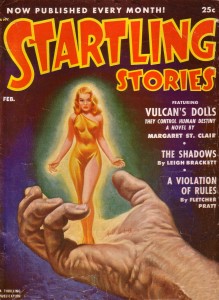 Vulcan’s Dolls
Vulcan’s Dolls
Margaret St. Clair
Startling Stories Feb. 1952, p. 10-73
When I posted my essay “The Women Other Women Don’t See“, I said I would be reading and reviewing the works of some of the women whose contributions to the field have been neglected. “Vulcan’s Dolls” and Margaret St. Clair are a perfect example.
Margaret St. Clair (1911-1995) was active in the field from the late 1940s through the early 1980s, but most of her work was published in the 1950s. Stories that appeared in F&SF carried the byline Idris Seabright. Today, to the extent that she’s known at all, she’s remembered for a handful of short stories.
“Vulcan’s Dolls” was billed as a novel on the cover of the issue of Startling Stories in which it appeared. Stories published as “novels” in the pulps usually weren’t long enough to be considered novels today or long enough to be reprinted in book form. Book length work, as a general rule, was published as serials. Consequently, “Vulcan’s Dolls” has never been reprinted. Startling Stories isn’t a highly sought after pulp, so copies shouldn’t be too hard to come by. I picked mine up at Half Price Books for $3.
Startling Stories, and to a lesser extent its sister publication Thrilling Wonder Stories, mixed fantasy in with the science fiction, sometimes blending the two together. “Vulcan’s Dolls” draws on Greek mythology (St. Clair had an educational background in the classics) but is inarguably science fiction, although the science doesn’t hold up to close scrutiny.
The viewpoint character, Don Haig, is an alcoholic living on an artificial planetoid. He sleeps in a lean-to down on the beach and does odd jobs for drinks or money he uses to buy drinks. One morning while bathing in the surf, he finds a doll in the sand. It’s a perfectly formed, naked female as long as his hand. And it’s crying. In fact, it never stops crying. (The source of the endless supply of tears is one of the logical flaws in the story.)
Haig takes the doll to his friend Kunitz, who tells him it’s one of Vulcan’s dolls. The only other one in existence is kept in a museum in New York and only displayed once every few years. Vulcan, Kunitz explains is an immortal who has a secret base at the end of the galaxy. Kunitz advises Haig to get rid of the doll.
Haig hangs onto it instead. He’s stubborn that way. The doll, which seems to emit a soft glow in dim lighting, begins to have an effect on Haig. He stops drinking. He finds a job. He takes an interest in things beyond where his next drink is going to come from.
Soon people are trying to take the doll from him. Some use subterfuge. Some attempt force. But a bond has formed between Haig and the doll, and the doll actively resists attempts to separate it from Haig.
Humanity suffered from a plague a generation or so back, and now is dominated by a government agency dedicated to stamping out not only mutations but any opposition. And the doll, and Haig along with it, have come to their attention.
There are levels of conspiracies in “Vulcan’s Dolls”. Some things don’t make sense at first but eventually are explained. Other things never make sense. At one point, St. Clair seems to say that humanity is still confined to the Sol system, but there are some problems with this, and not just the supposed workshop Vulcan has at the end of the galaxy. There’s also a prison planet that isn’t like any planet in the solar system, and since it has an atmosphere, it can’t simply be one discovered beyond the orbit of Neptune.
That was my biggest gripe with the story. I’ve taught astronomy at the university level, so this is the sort of thing that naturally bugs me. The rest of the story was engaging. Don Haig is a sympathetic, if somewhat flawed, protagonist. St. Clair makes some good points about free will and governments that try to control the choices its citizens have. And she does it without being heavy handed.
I especially liked the decision Haig made at the end, although I’m not sure I agree with it. Perhaps I should say I liked the way St. Clair handled his decision. It was consistent with the character as she had developed him.
“Vulcan’s Dolls” has never been reprinted, and I’m not sure if it’s up to contemporary standards. There were times when I got the impression that St. Clair was making the story up as she went along, usually when some new plot element was introduced without any warning. It isn’t long enough to be published in print form by a major publisher in today’s market. But it might do well as an ebook. Still, reading “Vulcan’s Dolls” was a pleasant way to spend a Saturday afternoon.


Actuality, Vulcan’s Dolls was half of an Ace Double back when there were Ace Doubles.
I didn’t know that. Thanks for the info.